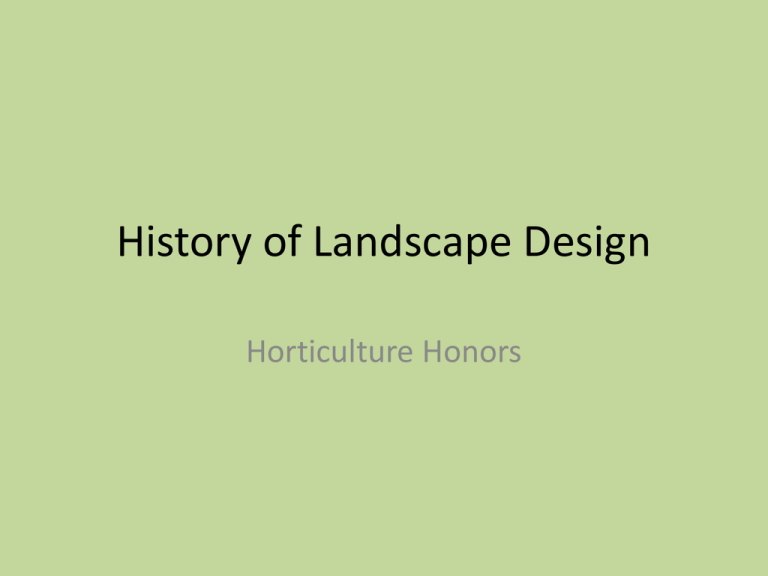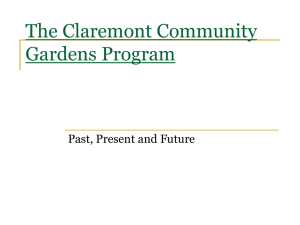History of Landscape Design
advertisement

History of Landscape Design Horticulture Honors Types of Gardens • • • • • Italian Renaissance French Renaissance English Formal or Cottage Japanese Colonial Italian Renaissance • Emerged in the late 15th century at villas in Rome and Florence • Inspired by classical ideals of order, harmony and beauty, recalling the virtues of Ancient Rome. • Leon Battista Alberti (1404-1472) was the most influential Italian Landscape Architect – He argued that a villa should both be looked at and a place to look from, that the house should be placed above the garden, where it can be seen and the owner can look down into the garden. Important elements of Italian Gardens • Elevation- terraces and different levels to the garden to create focal points and views using stairways and ramps to unite different levels • Fountains • Sculpture, especially mythological creatures • Parterres – beds created in geometric shapes and laid out in symmetrical patterns • Labyrinths Italian Garden Vocabulary • Fontaniere – the fountain-maker, a hydraulic engineer who designed the water system and fountains • Giochi d’acqua – water tricks. Concealed fountains which drenched unsuspecting visitors. • Bosco Sacro – sacred wood. A grove of trees inspired by groves where pagans would worship. This section was filled with statues of animals, giants and fantastic creatures. • Giardino Segreto – The Secret Garden. An enclosed private garden within the garden, inspired by the cloisters of Medievil monasteries. A place for reading, writing or quiet conversations. French Renaissance Gardens • Most significant in the 17th century • Based on symmetry and the principle of imposing order over nature. • Most well known for the Gardens of Versailles created by Andre’ Le Notre between 1662 and 1700 for King Louis XIV • Saw their work as a branch of architecture. The “walls” were composed of hedges and “stairways” of water. On the ground, carpets of grass or embroidered with plants and the trees were formed into curtains, along the alleys. Glossary of French Gardens • Parterre – a planting bed, usually square or rectangular, containing an ornamental design made with low closely clipped hedges, colored gravel, and sometimes flowers. – Laid out in geometrical patterns, divided by gravel paths – Intended to be seen from above from a house or terrace • Broderie – curling, decorative pattern within a parterre, created with trimmed yew or box or made by cutting a pattern out of a lawn and filled with colored gravel • Allée –A straight path, often lined with trees • Topiary – trees or bushes trimmed into ornamental shapes. • Patte d’Ole – (English trans, Goose foot) Three or five paths or allées which spread outward from a single point. Principles of the French Garden • A geometric plan using the most recent discoveries of perspective and optics • A terrace overlooking the garden, allowing the visitor to see all at once the entire garden. • All vegetation is constrained and directed, to demonstrate the mastery of man over nature. Trees planted in straight lines and carefully trimmed • The residence serves as the central point of the garden. No trees are planted too close to the house, rather the house is set apart by low parterres and trimmed bushes. • A central axis, or perspective, perpendicular to the façade of the house, on the side opposite the front entrance. – Axis extends either all the way to the horizon or to piece of statuary or architecture. – Principal axis is composed of a lawn or a basin of waterm,bordered by trees. – The principal axis is crossed by one of more perpendicular perspectives and alleys. • Elaborate parterres, or planting beds, in the shape of squares, ovals, circles or scrolls are placed in a regular and geometric order close to the house. • Parterres are filled with broderies, designs created with low boxwood to resemble the patterns of carpet using effects with flowers, colored brick, sand or gravel. • Bodies of water serve as mirrors, doubling the size of the house. • Garden is animated with pieces of sculpture and mark the intersection of the axes www.worldsiteguides.com/europe/fra nce/gardens-of-versailles/video New technologies of the French Garden • Geoplastie, the science of moving large amounts of earth. Came from the military, led to the development of baskets for carrying earth on the back, wheelbarrows, carts and wagons. Andre Le Notre used these methods to build the level terraces and to dig canals and basins on a grand scale. • Hydrology, bringing water to the gardens for the irrigation of the plants and for use in the many fountains (was not successful at Versailles) • Hydroplasie, the art and science of shaping water into different shapes as it came out of the fountain. Depended on the force of the water and the shape of the nozzle. Associated with fireworks at the time. Often accompanied by music. Flowers in French Gardens • Ornamental flowers were rare in French Gardens. • There was limited range of color: blue, pink, white and mauve. • Brighter colors would not arrive until about 1730, because of botanical discoveries from around the world. • Flowers were usually brought from Provence, kept in pots, and changed 3 or 4 times a year. • Versailles palace records from 1686 show that the Palace used 20,050 jonquil bulbs, 23,000 cyclamen and 1700 lily plants in one spring season. Other pictures of french gardens English Gardens •Emerged in the 18th century replacing the more formal, symmetrical French Garden as the principal gardening style of Europe. •Inspired by an idealized view of nature, not architecture for the first time. Important designers of English Gardens •Lancelot “Capability” Brown – gardener under Charles Bridgeman but became most influential figure in later development of English Garden. • William Kent – an architect, painter and furniture designer. His gardens were designed to compliment the Palladian architecture of the houses he built. • Charles Bridgeman- son of a gardener, experienced horticulturist. Became Royal gardener for Queene Anne and Prince George of Denmark. Responsible for tending and redesigning the royal gardens at Windsor, Kensington Palace. Lancelot “Capability” Brown • Contribution was to simplify the garden by eleminating geometric structures, alleys and parterres near the house and replacing them with rolling lawns and extensive views. • He created artificial lakes and used dams and canals to transform streams or springs into the illusion that a river flowed through the gardens. •17th century English gardens were also influenced by Chinese gardens •Noted that Chinese gardens avoided formal rows of trees and flower beds, and instead placed trees and plants in irregular ways to strike the eye and create beautiful composition. •During the 18th century the French designers began to adapt the English styles. •The new style also had the advantage of requiring fewer gardeners, and was easier to maintain than then French Garden. Principles of English Garden • Gently rolling beds • Water in the form of small ponds of streams • Piers or bridges • More flowers then the French • Often used a round or hexagonal pavilion or other pieces of architecture out in the garden • Smaller scale garden English Cottage Garden Style • Emerged in the 1870s • Style that uses an informal design, traditional materials, dense plantings and a mixture of ornamental and edible plants. • Depends on grace and charm rather than grandeur and formal structure. • More functional and easier to care for. • Closer to the house, better for smaller property owners. •Emphasis was on vegetables and herbs, along with some fruit trees. •Flowers were used to fill and spaces in between. •Over time flowers became more dominant creating cut flowers for the owners use and decoration. •Cottages garden were developed out of necessity for the working class to grow their food at their homes. As times got better, more flowers were seen as the gardens were able to become less functional and more aesthetic. •Very few hard scapes were found. Sometimes a simple gravel path would be found but always twisting and winding paths. Never geometric or symmetrical. Japanese Garden Traditional gardens that create miniature idealized landscapes •Gardens of emperors and nobles were designed for recreation and aesthetic pleasure •Gardens of Buddhist temples were designed for contemplation and meditation. Japanese Garden styles Rock gardens or zen gardens – meditation gardens where white sand replaces water Roji – simple, rustic gardens with teahouses where the Japanese tea ceremony is conducted Promenade or stroll gardens with teahouses where the Japanese tea ceremony is conducted Small courtyard gardens Japanese Garden elements Water • either a pond or stream or represented by white sand. • In Buddhist symbolism, water and stone are the ying-yang, two opposites which complemented and complete each. • Will have an irregular shaped pond or in a larger garden, several ponds connected by a channel or stream and a cascade, a miniature waterfall Water should enter the garden from the east or southeast, and flow toward the west because the east is the home of the Green Dragon an ancient Chinese divinity adapted in Japan, and the west is the home of the White Tiger, the divinity of the east. •Water flowing from east to west will carry away evil and the owner of the garden will be healthy and have a long life Rocks and Sand • Rocks were used to represent mountains, places and things. • A three rock arrangement usually represented heaven, earth and humanity. • Sand and gravel were used around shrines and temples but were later used in Zen gardens to represent water or clouds. • White sand represented purity, but sand could also be gray, brown or bluish-black. Garden architecture • Designed to be seen from the main buildings and its verandas or from small pavilions • Rustic teahouse were hidden in the gardens and small benches and open pavilions provided places for rest and contemplation. • The garden and the house became one. • Used sliding doors on the teahouses to open out into the garden Garden Bridges • Symbolized the path to paradise and immortality • Could be made of stone, wood or logs with earth on top, covered with moss • Could be arched or flat • Often painted red if part of a temple garden Stone lanterns and water basins Stone lanterns – represents the five elements of Buddhist cosmology. • the part touching the ground represents the chi, the earth •The next section represents sui, water •The section encasing the lanterns light or flame, represents ka or fire •The last two sections top-most and pointing to the sky represent fū, air and kū, void or spirit. Water basins – originally places for visitors to wash their hands and mouth before tea ceremony •Water is provided to the basin by a bamboo pipe •Usually has a wooden ladle for drinking •Placed low to the ground Garden fences and gates Trees and flowers • Nothing is left to chance or left natural • Trees carefully chosen and arranged for their autumn colors • Moss is used to suggest that the garden is ancient • Flowers carefully chosen by their flowering season • Trees are trimmed to provide attractive scenes, a techmique called Niwaki Fish Principles of Japanese Gardens • Miniaturization –The Japanese Garden is a miniature and idealized view of nature. Rocks can represent mountains and ponds can represent seas. • Concealment – The Zen Buddhist garden is meant to be seen all at once, but the promenade garden is meant to be seen one landscape at a time, like a scroll of painted landscapes unrolling. Features are hidden behind hills, tree groves or bamboo, walls or structures, to be discovered when the visitor follows the winding path. • “Borrowed” Scenery –smaller gardens are often designed to incorporate views of features outside the garden, such as trees, hills, or temples. Makes the garden seem larger than it is. • Asymmetry – Not laid on straight axes, or with a single feature dominating the view.Buildings and garden features are usually seem from a diagonal. Colonial Revival garden style • Popular from the late 1800s to the late 1930s in the United States, mostly eatern (where colonial British heritage was strongest). • Typified by simple rectilinear beds, straight pathways through the garden and perennial plants from the fruit, ornamental flower and vegetable groups. Elements of Colonial • Tended to be small and close to the house • Usually enclosed , often by low walls, fences or hedges. • Straight walkway generally extended on a line equal with the entrance to the house through the center of the garden • Beds usually raised for drainage • Planting beds were usually square or rectangular • Paths were made of brick, gravel or stone • Picket fences were common






